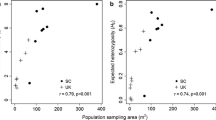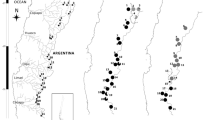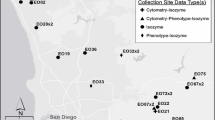Abstract
The Mediterranean Basin is a biodiversity hotspot, housing >11.000 narrowly endemic plant species, many of which are declining due to mass tourism and agricultural intensification. To investigate the genetic resource impacts of ongoing habitat loss and degradation, we characterized the genetic variation in the last known populations of Leopoldia gussonei, a self-compatible endangered Sicilian Grape Hyacinth numbering less than 3,000 remaining individuals, using AFLP. Results demonstrated significant genome-wide genetic differentiation among all extant populations (ΦST = 0.05–0.56), and genetic clustering according to geographic location. Gene diversity was fairly constant across population (mean HE = 0.13) and was neither affected by current population size nor by spatial isolation. Vegetation analysis showed the presence of known invasive weeds in a quarter of the populations, but we found no relation between genetic diversity and plant community composition. The marked genetic differences among populations and the profusion of rare and private alleles indicate that any further population loss will lead to significant losses of genetic diversity. Conservation efforts should therefore focus on the preservation of all sites where L. gussonei still occurs, yet the deliberate introduction of diverse material into the smallest populations seems unneeded as clonality likely mitigated genetic drift effects thus far. More generally, our findings support the view that endemic plant species with a narrow ecological amplitude, as many specialists in Mediterranean coastal ecosystems, are highly genetically differentiated and that conservation of their genetic diversity requires preservation of most, if not all of their extant populations.





Similar content being viewed by others
References
Aguilar R, Quesada M, Ashworth L, Lobo J, Herrarias-Diego (2008) Genetic consequences of habitat fragmentation in plant populations: susceptible signals in plant traits and methodological approaches. Mol Ecol 17:5177–5188
Albo G (1919) La vita delle piante vascolari nella Sicilia meridionale-orientale. Parte II, Flora
Bakker JP (1976) Phytogeographical aspects of the vegetation of the outer dunes in the Atlantic province of Europe. J Biogeogr 3:85–104
Breinholt JW, Van Buren R, Kopp OR, Stephen CL (2009) Population genetic structure of an endangered Utah endemic Astragalus ampullarioides (Fabaceae) (Welsh) Welsh. Amer J Bot 96:1–7
Brullo S, Marcenò C (1974) Vulpio-Leopoldietum gussonei ass. nov. dell’Alkanneto-Malcolmion nella Sicilia meridionale. Notiziario Fitosociologico 8:75–85
Brullo C, Giusso del Galdo G, Marcenò C, Minissale P, Sciandrello S (2011) Leopoldia gussonei. In: IUCN 2012. IUCN Red list of threatened species. Version 2012.1. www.iucnredlist.org. Downloaded on 24 June 2012
Cole CT (2003) Genetic variation in rare and common plants. Annu Rev Ecol Syst 34:213–237
Crema S, Cristofolini G, Rossi M, Conte L (2009) High genetic diversity detected in the endemic Primula apennina Widmer (Primulaceae) using ISSR fingertyping. Pl Syst Evol 280:29–36
Cundari R, Fontana F, Giardina G, Longhitano N (2003) La flora della Riserva N.O. “Pino d’Aleppo” (Sicilia Meridionale-Orientale). In: Italian Botanical Society (ed.), 98° Congresso S.B.I. Riassunti, 229, Catania
Dallman PF (1998) Plant life in the World’s Mediterranean climates. California native plant society. University of California Press, Berkeley
de Vere N, Jongejans E, Plowman A, Williams E (2009) Population size and habitat quality affect genetic diversity and fitness in the clonal herb Cirsium dissectum. Oecologia 159:59–68
Ellstrand NC, Elam DR (1993) Population genetic consequences of small population size: implications for plant conservation. Annu Rev Ecol Syst 24:217–242
Evanno G, Regnaut S, Goudet J (2005) Detecting the number of clusters of individuals using the software STRUCTURE: a simulation study. Mol Ecol 14:2611–2620
Excoffier L, Smouse PE, Quattro JM (1992) Analysis of molecular variance inferred from metric distances among DNA haplotypes: application to human mitochondrial DNA restriction sites. Genetics 131:479–491
Falush D, Stephens M, Pritchard JK (2007) Inference of population structure using multilocus genotype data: dominant markers and null alleles. Mol Ecol Notes 7:574–578
Frey DJ, Haag CR, Kozlowski G, Mráz P (2012) High genetic and morphological diversity despite range contraction in the diploid Hieracium eriophorum (Asteraceae) endemic to the coastal sand dunes of South-Western France. Bot J Linn Soc 169:365–377
Garbari F, Di Martino A (1972) Leopoldia gussonei Parl. (Liliaceae), species endemica siciliana. Webbia 27:289–297
Géhu JM, Franck J (1985) Données synchorologiques sur la végétation littorale européenne. Vegetatio 59:73–83
Gitzendanner MA, Soltis PS (2000) Patterns of genetic variation in rare and widespread plant congeners. Amer J Bot 87:783–792
Greuter W (1991) Botanical diversity, endemism, rarity, and extinction in the Mediterranean area: an analysis based on the published volumes of med-checklist. Bot Chron (Patras) 10:63–79
Greuter W (1994) Extinctions in Mediterranean areas. Philos Trans Ser B 344:41–46
Haig SM (1998) Molecular contributions to conservation. Ecology 79:413–425
Hamrick JL, Godt MJW (1996) Effects of life history traits on genetic diversity in plant species. Phil Trans Roy Soc London Biol Sci 351:1291–1298
Hill MO, Gauch HG (1980) Detrended correspondence analysis: an improved ordination technique. Vegetatio 42:47–58
Honnay O, Jacquemyn H (2007) Susceptibility of common and rare plant species to the genetic consequences of habitat fragmentation. Conserv Biol 21:823–831
Honnay O, Jacquemyn H, Roldán-Ruiz I, Hermy M (2006) Consequences of prolonged clonal growth on local and regional genetic structure and fruiting success of the forest perennial Maianthemum bifolium. Oikos 112:21–30
Huff DR, Peakall R, Smouse PE (1993) RAPD variation within and among populations of outcrossing buffalograss (Buchloë dactyloides (Nutt.) Engelm). Theor Appl Genet 86:927–934
Juan A, Crespo MB, Cowan RS, Lexer C, Fay MF (2004) Patterns of variability and gene flow in Medicago citrina, an endangered endemic of islands in the western Mediterranean, as revealed by amplified fragment length polymorphism (AFLP). Mol Ecol 13:2679–2690
Jump AS, Marchant R, Peñuelas J (2009) Environmental change and the option value of genetic diversity. Trends Plant Sci 14:51–58
Leimu R, Mutikainen P, Koricheva J et al (2006) How general are positive associations between population size, fitness, and genetic variation? J Ecol 94:942–952
Liu YF, Wang Y, Huang H (2006) High interpopulation genetic differentiation and unidirectional linear migration patterns in Myricaria laxiflora (Tamaricaceae), an endemic riparian plant in the three Gorges Valley of the Yangtze river. Amer J Bot 93:206–215
Luijten SH, Dierick A, Oostermeijer JGB, Raijmann LEL, Den Nijs HCM (2000) Population size, genetic variation, and reproductive success in a rapidly declining, self-incompatible perennial (Arnica montana) in The Netherlands. Cons Biol 14:1776–1787
Médail F, Quézel P (1999) Biodiversity hotspots in the Mediterranean Basin: setting global conservation priorities. Cons Biol 13:1510–1513
Neel MC (2008) Patch connectivity and genetic diversity conservation in the federally endangered and narrowly endemic plant species Astragalus albens (Fabaceae). Biol Conservation 141:938–955
Nielsen LR (2004) Molecular differentiation within and among Island Populations of the Endemic Plant Scalesia affinis (Asteraceae) from the Galápagos Islands. Heredity 93:434–442
Nybom H (2004) Comparison of different nuclear DNA markers for estimating intraspecific genetic diversity in plants. Mol Ecol 13:1143–1155
Palacios C, Kresovich S, González-Candelas F (1999) A population genetic study of the endangered plant species Limonium dufourii (Plumbaginaceae) based on amplified fragment length polymorphism (AFLP). Mol Ecol 8:645–657
Palop-Esteban M, Segarra-Moragues JG, González-Candelas F (2007) Historical and biological determinants of genetic diversity in the highly endemic triploid sea lavender Limonium dufourii (Plumbaginaceae). Mol Ecol 16:3814–3827
Peakall R, Smouse PE (2006) GENALEX 6: genetic analysis in Excel. Population genetic software for teaching and research. Mol Ecol Notes 6:288–295
Pritchard JK, Stephens M, Donnelly P (2000) Inference of population structure using multilocus genotype data. Genetics 155:945–959
Reed DH, Frankham R (2003) Correlation between fitness and genetic diversity. Conserv Biol 17:230–237
Schoen DJ, Brown AHD (2001) The conservation of wild plant species in seed banks. Bioscience 51:960–966
Segarra-Moragues JG, Catalán P (2010) The fewer and the better: prioritization of populations for conservation under limited resources, a study with Borderea pyrenaica (Dioscoreaceae) in the Pyrenean National Park. Genetica 138:363–376
Suc JP (1984) Origin and evolution of the Mediterranean vegetation and climate in Europe. Nature 307:428–429
USDA, NRCS (2010) The PLANTS database. National Plant Data Center, Baton Rouge
van der Maarel E, van der Maarel-Versluys M (1996) Distribution and conservation status of littoral vascular plant species along the European coasts. J Coast Conserv 2:73–92
vanden Berghen C (1964) Notes sur la végétation du sud-ouest de la France I: la végétation des dunes mobiles. Bull Jard Bot État Bruxelles 34:519–525
Vandepitte K, Jacquemyn H, Roldán-Ruiz I, Honnay O (2007) Landscape genetics of the self-compatible forest herb Geum urbanum: effects of habitat age, fragmentation and local environment. Mol Ecol 16:4171–4179
Vandepitte K, Gristina A, Meekers T, de Hert K, Roldan-Ruiz I, Honnay O (2012) Recolonization after habitat restoration leads to decreased genetic variation in populations of a terrestrial orchid. Mol Ecol (in press). doi: 10.1111/j.1365-294X.2012.05698.x
Vekemans X (2002) AFLPsurv version 1.0: a program for genetic diversity analysis with AFLP (and RAPD) population data. Laboratoire de Génétique et Ecologie végétales, Université Libre de Bruxelles
Vergeer P, Rengelink R, Copal A, Ouborg NJ (2003) The interacting effects of genetic variation, habitat quality and population size on performance of Succisa pratensis. J Ecol 91:18–26
Vos P, Hogers R, Bleeker M et al (1995) AFLP—a new technique for DNA-fingerprinting. Nucleic Acids Res 3:4407–4414
Waples RS (1995) Evolutionarily significant units and the conservation of biological diversity under the Endangered Species Act. Am Fish Society Symp 17:8–27
Weber E, D’Antonio CM (1999) Phenotypic plasticity in hybridizing Carpobrotus ssp. (Aizoaceae) from coastal California and its role in plant invasion. Canad J Bot 77:1411–1418
Wright S (1938) Size of population and breeding structure in relation to evolution. Science 87:430–431
Young A, Boyle T, Brown A (1996) The population genetic consequences of habitat fragmentation for plants. Trends Ecol Evol 11:413–418
Zhivotovsky LA (1999) Estimating population structure in diploids with multilocus dominant DNA markers. Mol Ecol 8:907–913
Acknowledgments
KV holds a postdoctoral fellowship of the Research Foundation—Flanders (FWO).
Author information
Authors and Affiliations
Corresponding author
Rights and permissions
About this article
Cite this article
Vandepitte, K., Gristina, A.S., De Raedt, R. et al. Conservation genetics of an endemic from the Mediterranean Basin: high genetic differentiation but no genetic diversity loss from the last populations of the Sicilian Grape Hyacinth Leopoldia gussonei . Conserv Genet 14, 963–972 (2013). https://doi.org/10.1007/s10592-013-0487-6
Received:
Accepted:
Published:
Issue Date:
DOI: https://doi.org/10.1007/s10592-013-0487-6




